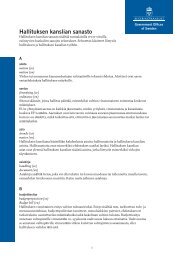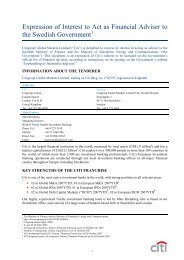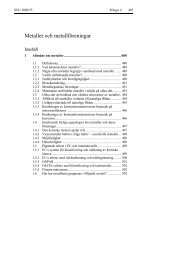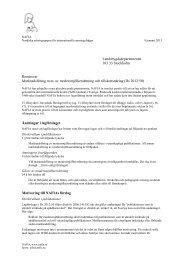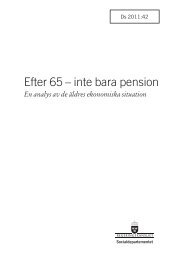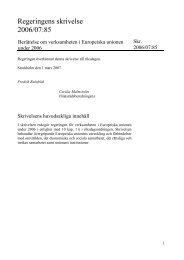versus high school-level jobs Erik Mellander and Per ... - Regeringen
versus high school-level jobs Erik Mellander and Per ... - Regeringen
versus high school-level jobs Erik Mellander and Per ... - Regeringen
Create successful ePaper yourself
Turn your PDF publications into a flip-book with our unique Google optimized e-Paper software.
SIVEDISH ECOlXOMIC POLICY RIIVIEW 6 (1999) 119-187Corporate job ladders in Europe: wage premiafor universiv- <strong>versus</strong> <strong>high</strong> <strong>school</strong>-<strong>level</strong> <strong>jobs</strong><strong>Erik</strong> <strong>Mell<strong>and</strong>er</strong> <strong>and</strong> <strong>Per</strong> Skedinger 'Investment in human capit'll is ;I central issue in the ltterature oneconomic growth. The purpose of thts study is to shed llght on theeconomic mcentlves for investment In unlverstt! educatiorl acrosscountries. It presents an empirtcal investtgatton of earnings for private-sectorengneers <strong>and</strong> business admtntstr'ltors tn seven Europeancountrtes pelgum, Denmark, France, German!, Ital!, ST\ eden, 'lndthe UK). The anal~ sts IS based on a large mtcro d'lta set th~tIS tde'lll~sutted for intern'lttonal comparisons. It contains ~nform'ltion one'lrnings, age. occup'ltion, responstbtltty <strong>level</strong>, tndustq, 'lnd firm size.St<strong>and</strong>xdised \\-age premia for universitj- <strong>versus</strong> htgh <strong>school</strong>-<strong>level</strong><strong>jobs</strong> are computed for exh countq <strong>and</strong> field of nork. The resultsindicate th~tthe wage premia 'Ire htgher for bustness administratorsthan for engneers in all the countries constdered <strong>and</strong> that the premiafor engineers are rernark'lhl! similar across countries. Agregattonover fields of work. \\-htch 1s common in studtes on the returns toeducatton, therefore seems to be questionable prdcttce \\-hen compartngthe returns tn dtfferent countries. &!Resea~chjLIow.r af the Resea~ch Instifufe 4 It~dwt,iaL Eco~zomics (IVI) i?z Stockholm. Bo~hare afihated z~ifh fhe O$ce ofLa/iou:- Ma:-ket Po& EtaLz~ntiofi PAU) i?z UpsaLa.
SXFDISH ECO\OAIIC POLICY RE\?E\I 6 (1999) 449-487Corpsgate job ladders in Eu~oge:wage p~emira fan univensitgr- <strong>versus</strong><strong>high</strong> <strong>school</strong>-<strong>level</strong> <strong>jobs</strong>I Crik AIell<strong>and</strong>er <strong>and</strong> <strong>Per</strong> Skedinger 'Tlxs p'lper presents an empirical investigation of e'lrnings for priv'ltesectorengneers <strong>and</strong> business administrators in seven Europeancountries (Belgium, Denmark, France, Germany, Italy, Sneden, <strong>and</strong>the UI
CORPORlTE JOB L-ADDERS Ih EUROPE, Enk L/Iell<strong>and</strong>er <strong>and</strong> <strong>Per</strong> SkedingerPre~-ious analyses of the returns to education use single-countrydatabases.' Comparability of these estimates across countries is oftenlimited due to the different wage measures <strong>and</strong> time periods q-picallybeing used. Like the aggregational issues, these comparabiliq- problemsare well known but rarely addressed in the literature. Our multicountrydata set offers an opportunity to overcome them.The purpose of this stud!- is to shed light on the economic incentivesfor investment in university education across countries. Investmentin human capital is a central issue in the literature on economicgrowth. Changes 01-er time in the quality of labour hax-e been putforward as an explanation for the residual in growth accountingstudies.' The growth perspective provides another rationale for notgrouping education categories in the analysis arld for focusing on enpeering<strong>and</strong> business administration. It is argued that an increasedsupplj- of graduates in engneering or business administration is moreimportant for growth than an increase in, say, theoretical philosophyor the fine arts. Murphy et al. (1991) find evidence that countrieswith a large share of students in engneering grow faster than othercountries.A graduate in engneering (or business administration) may, however,not rlecessarily remain in the countq- of orign. Because of theintegration of labour markets within the European Union (ELI),earnings differentials, which will induce labour flows between countries,are smaller todaj- than a decade ago <strong>and</strong> will probably decreaseeven further. Although labour migration among EU countries is stillnegligble, the migration that occurs seems to be concentrated towell-educated people <strong>and</strong> to be growing.4 So there is potential forgrowth-reducing brain drain from countries that turn out to be lesssuccessful in competing for key segments of the labour force.A discussion of the brain-drain problem is beyond the scope ofthis paper; such a discussion would require an explicit analysis ofwage differentials between countries. But besides cross-country wagedifferentials, the relative wage structure ~t~ithin countries probably influencesmigration decisions. TO this extent, our anal!-sis should be ofSee, e.g., I-'sacharopoulos (1994) for an extensive review.See, e.g., Denison (1962) or Griliches (1970).4 See NorBo Econolnics (1998) for Swedish evidence on international migration of<strong>high</strong>ly skilled labour.
CORPORATE JOB 1,ADDERS IN El-ROPE, Ei~k hfell<strong>and</strong>er <strong>and</strong> <strong>Per</strong> Skedlngerreler ance for the debate on the drir irig forces behind the brain drainphenomenon.'The paper is org'lnised as follons. Section I describes the d,~t,~.Section 2 considers ser era1 aggreg,~tional issues that arise in the empiricalanalysis. Section 3 specifies the n age premia computations ,~ndthe underlying wage equations. Section 4 reports the empiric,~l results,<strong>and</strong> Section 3 cont'lins concluding comments <strong>and</strong> suggestions forfurther rese'lrch.la The dataOur data come from yearly surveys conducted by Vi atson UTyatt. Theresponding firms are not sampled (but possiblj~ contacted) by \'atsonWyatt; the firms decide whether they want to particip'lte, in exchangefor access to reports on the results. Firms that oper'lte internationalljare over-represented because by participating, they get updated~nformation about employment terms <strong>and</strong> conditions in countrieswhere they are operating or planning to set up business. Thelarge majority of firms are foreign onned, with p'lrent companiesbased predom~nantl~ in theThe non-r<strong>and</strong>om nature of the data limtts the population forn hich n e can make inferences. But there are quite ,I few people n hon ork in internationally ;~ctir e firms in the prir ate sector. Moreor er,by confining our 'Ittention to people in competitir e labour markets,n e c'ln be confident that the n ages n e obsen e are outcomes of theinterplay bemeen supply ,~nd dem<strong>and</strong> forces, in accordance with CISsumptionsunderlying humm capital theory. In nationally represent'ltne surveys, this presumption probably does not dpplj~ to '111 persons;some may be n orking ln, e.g.. <strong>high</strong>ly regulated labour markets. Ind,5 The present stud!- concerns relative wages across European countlies in tlle recentpast. Other studies deal with relative-wage developments ores longer timepeiiods. For exanple, while OECD (1996) reports that in the LTIi the relativewages of <strong>high</strong>-skilled workers have rise11 sharpl!- since the mid-1980s. Gunnarsson<strong>and</strong> <strong>Mell<strong>and</strong>er</strong> (1999) show that in Sweden, relative wages were allnost constantduiing the sane period.Wefore the 1998 sun-e!-, R'atson \X!-att did not collect infollnation about the parentcornpan!-'s nationality. So it is not available for the 1993-96 period of ourstlldj-. In 1998, the share of firms with a foreign parent coinpmj- was: Belgum89'W. Denmark 98" b, France 91y0, Germany 91!/0, Italy 930/0, Sweden 83'10. <strong>and</strong>the TJIi 93!/0. In the seven countries, between 47'4b <strong>and</strong> 70% of the firms wereassociated with a IJS parent company. .iccording to R'atson Wj~att. the figures fortlle 1993-96 sample are probably not ve? different.
CORPO-UTE JOB LADDERS IN EUROPE, Enk <strong>Mell<strong>and</strong>er</strong> <strong>and</strong> <strong>Per</strong> Skedingerto extend this comparison, national surveys generdllj- differ acrosscountries. This is not the case here; the same questionnaire mas usedin all countries. Furthermore, great care is taken in the data collectionto ascertain that the responses are directly comparable across individuals,firms, <strong>and</strong> countries. For example, a \Tatson W7yatt representativewill always assist the firm the first time it participates in thesurvey. So m-l~ile we will not be able to draw general conclusions, tliepopulation for which we can make inference is substantial in mapitudeilnd of considerable interest, <strong>and</strong> the data upon \vhicli our inferenceis to be based is of unusual quality.The datil consist of annual cross-sections for engneers <strong>and</strong> businessadministrators during 1993-1996 The cross-sections partly07-erlap in the sense tliat the same people maj- be included for severalyears. Unfortunately, we lack employee identifiers <strong>and</strong> thus cannotconstruct a panel dim set. But firm identifiers are available, <strong>and</strong> thisenables us to do better than just treat our data as repeated crosssections.L4s a complement to the bur cross-sections, we have used thefirm identifiers to construct two-year overlapping panels of firms for1993-94, 1994-95, <strong>and</strong> 1995-96 for each In this waj-, me canavoid noise due to entn- <strong>and</strong> exit of firms when \ve compare wagepremia betu-een the years t <strong>and</strong> 2+1, Together, the three panels yieldsix different wage premia (1993, 1994:H, 1994:lH, 199J:I, 1995:II, <strong>and</strong>1996).Altogether, our data set covers 15 different <strong>jobs</strong>: 8 engneering<strong>jobs</strong> <strong>and</strong> 7 business administration <strong>jobs</strong>. In Table we classifj- the<strong>jobs</strong> by field of \vork <strong>and</strong> education <strong>level</strong>.In principle, me could go further <strong>and</strong> construct data sets containing obsen-ationsfrom tlie same set of firms for all of tlie four years. Hou;erer, that would result indata sets a-ith too few observations to permit meaningful statistical malyses.
lsn! $1 'wa~qo~d E lorr sr s~yl 'kq-1p3npo~d se qsns ' S ~ ~ S ~ ~ T ~ EpaNasqoun J I ? ~ Z J uopaseq sqo! olur saqaswaq J J ~ S o y ssayxofi ~ go slInsax aq an sayurorre asaq JEL~luaJsa ayl o~ ,sqo! al~np~Suou Zurp~oy an: sxaqmu palmnpa-&~sxa~\~unsuopellrasqo an alayl $ELF a~q~ssod L11~3pa1oaq sr l~ 'sq2ay3 Ino Lq pawsrpur Torra1Fyla 'osb- F-saaSap hyssa-~rrrn Zuy-IE~ lnorppy sqo! a ~enp~S ddn3so 0y.u a~doaduo suop~~~~asqo awos rryrror, d ~q~qo~d EJEP Jno leq alesrpur sy3ays -hrp~~~ayA'1 a1qeL ur sano2ayzs uopzsnpa8 . .arly uoddns d1a2lq 'g x ~uaddy u! a;rz y3!y~ 'sq3ay3 asayL .uop-eru;rojur .i;rzyuarua1duros uo paszq 'sysays &!p!jz-1 IzJa-kas paru~o3;rada~u '1 alqzL ur suoazsgrssz13-ssol3 30 -h!p1lz-1 ayj aupzsa o~ .(sqo!alenpesuou ayl) 1oorlss .i;rzpuo3as ~addn ;ro loorl3s y81y oy 8urpuodsa.rzo3 uopcsnpa rn: .ro (sqo! alznpzB ayr) uo!w3npa lanal-h!s;ra-~-run e Jayyra a;rmba~ li1qzqold day1 'a8~.~a,?a uo 'asnmaq pay3aIas alalusqo! pazaprsuo3 ayj lng .uel& uoslzlfi dq pay3a11o3 IOU s! uoperu;roj-ur, sryl . asnwaq 'uuope3npa 'saado1dwa ayl lnoqz uoperu~03u! yqd-sa uo paszq you s! 1 a1qzL u! lanai uopmnpa dq uopzsrj1ssz13 ayj,.sauyunos prre sru~rj sso;r3z alqz~zdruo3 s! sqo!snorleh olur saado1drua jo uoaesrj!sseIs ayllzrly aznsua 04 uojja aiqe-1aprsuo3 sale-kap osje ueXlfi uosyzm .T a1qz;L u! sa!zo2alz3 11103 ayljo y3za lo3 auo 'suoryz3rjr3ads qo! asayy jo sajdwzxa znoj su!zlu03 yxrpuaddy .Irelap lzaa UI parjpads ale sqo! 'dauns sjlzXm uoslzar\\ u~
COKPORATE JOB LADDERS IN EUROPE, Enk A/Iell<strong>and</strong>er <strong>and</strong> <strong>Per</strong> SkedlngerTable 2 presents the number of observations broken down blcountry,graduate/nongraduate <strong>jobs</strong>, <strong>and</strong> I-ear.Table 2. Number of abse~~vations by country <strong>and</strong> educationes~es,I ssa-9s.a. EngineersSweden 77 154 104 179 183 414 133 335Some countries, particularly Denmark <strong>and</strong> Sweden, exhibit considerablechanges in the number of observations over time. Forgoes to show that competence <strong>and</strong> education are not necessarily the same thing.The labour market primarily rewards competencies, at least in the long nln. So it isnatural to define the university wage premium as the relative wage hfference betweencompetencies that nomzaL4 require unirersity <strong>and</strong> <strong>high</strong> <strong>school</strong> degrees, respectively,n-ithin a gven field. If a <strong>high</strong>-<strong>school</strong> educated person has been able toacquire the competence usually associated with a unirersity education, then it isappropriate in this context to treat her as if unirersity educated. And the fact that aperson with a unirersi5- degree is holding a <strong>high</strong>-<strong>school</strong> <strong>level</strong> job may be due, e.g.,to hzving a degree in another field of n-ork (such as history) or simply that he hasgone through the university without increasing his competence (very much). Ineither case, there is no reason to treat such a person as university educated m'thre~pezto the z>forkjr wilil-h he ol- she is emplyed.
CORPORITE JOB LADDERS IN EIJROPE. Enk AIell<strong>and</strong>er <strong>and</strong> <strong>Per</strong> SkedingerDenmark, the numbers of obsen-ations decrease over time ml~~le theoppostte is true for Sweden. Regarding Denmark, note that the numbersof obsensrat~ons are quite small; except for engneenng graduates<strong>and</strong> business ~dmrnistration nongradu~tes In 1993 <strong>and</strong> 1994, there areless than 100 observations on the Aggregates of gradu~te lesel Andnongr~duate-le~ el <strong>jobs</strong>.Besides job <strong>and</strong> countq7!-, we h~ve the folloii-ing data for each personm es ery year: \\-Age, age, responsibility les el, the number of employeesat the work site, <strong>and</strong> an industry code.The wage corresponds to full-time emplo~ment And IS the sum ofthree components:1. The fixed (base) salary plus guaranteed add~tiorlal pa! :nents. suchas legal vacation <strong>and</strong> extra contractual mont11s92. Variable rewards in the form of bonuses, such as profit-sharingschemes3. Sales commlsstons, to the extent that these are related to salesperform~nce.Table 3 presents the real iiages, denominated in local currenc~es <strong>and</strong>expressed in 6996 prices, broken down by countn <strong>and</strong> graduate <strong>versus</strong> nongraduate <strong>jobs</strong>It can be seen that v\itl~ni the four categories of employees(graduate <strong>and</strong> rlongraduate <strong>jobs</strong> in engineering <strong>and</strong> business admintstration,respectii ely), real v\ ages were quite stable over the four-yearperiod in all countries. ,inother ohsewation is that graduate <strong>jobs</strong> inbusiness administration seem to be better patd than graduate en@-neering <strong>jobs</strong>. Th~s particul~rl~ Applies in Belgum, France, the &'I
CORPORATE TOB LADDERS IN EUROPE, Enk <strong>Mell<strong>and</strong>er</strong> <strong>and</strong> <strong>Per</strong> SkedingerTabBe 3. Weans of seal annual salary by country <strong>and</strong> ...a. Engineersb. Business acdnainistratorsGermany (DEM) 123,095 70,928 122,765 73,536
CORPOR ITEJOB LADDERS IK EUROPE, <strong>Erik</strong> AIell<strong>and</strong>er <strong>and</strong> <strong>Per</strong> Sked~nger. .. education Bevel, 1993-96 (BocaD currencies).5re.r: Salasies include bonus <strong>and</strong> coinmission <strong>and</strong> are in 1996 psices. OECD: i\tlirinEzonomz~. Indiiato;~ is the source for the consunler psice index 111 each country. Belgian<strong>and</strong> Italian salailes are in BFRx 100 <strong>and</strong> ITL x 1000.
CORPORATE JOB LADDERS 1N EUROPE, <strong>Erik</strong> <strong>Mell<strong>and</strong>er</strong> <strong>and</strong> <strong>Per</strong> SkedingerTable 4. Raw wage premla for graduate ws. nongraduate <strong>jobs</strong>,by country, 1993-96 (%).b. Business administratorsNote: The wage premium is computed by dividing the wage for the university<strong>level</strong><strong>jobs</strong> with the wage for the <strong>high</strong> <strong>school</strong>-<strong>level</strong> <strong>jobs</strong> (from Table 3), subtracting 1from the resulting number <strong>and</strong> multipl!-ing by 100.For example, the largest of the average wage prernia for engneersis in Germany <strong>and</strong> amounts to 50%. This is only slightly <strong>high</strong>er thanthe lowest of the raw premia for business administrators-45% inDenmark. The spread among the countries is also much larger forbusiness administrators; the premia vary from 45% in Denmark to96% in the UI
CORPOIWTE TOB LADDERS IV EUROPE, E,nk Sfell<strong>and</strong>er <strong>and</strong> <strong>Per</strong> SkedlngerTable 5. Means of selected variables by country <strong>and</strong>education lave!, 1993-96.Country Age RssponsibiBBty IevsB Ms. employeesGrad Non- Grad Non- Grad Mn-b. Business administratorsSweden 39.5 41.9 27/45 21/57 1486 747Tote The hvo figures for responslbll~tr le~el refer to the slia~e, in percent. ofn orkels at ' 4' ,md '3' le1 els, respectn ellIt can be seen th~the mean ages are very similar, across countrtes,betneen graduate- <strong>and</strong> nongraduate-<strong>level</strong> <strong>jobs</strong> <strong>and</strong> across fieldsof work (1.e. engineering ,~nd business administration). The correspondingar erages are all bemeen 36 <strong>and</strong> 43 years.Tlie persqn's ie.pri~zrlbzlzG <strong>level</strong>is measured on an ordinal scale thatcontains three lerels: 4 (l?tgl~est), R, <strong>and</strong> C (lowest). These are relati1 e concepts, defined in relat~orl to the respectirTe <strong>jobs</strong>; cf. 4ppendix1. In genernl, the reiponsibility <strong>level</strong> tends to increase mitli age,whicl~ lends support to the interpretation of tl~is variable as definingcareer l,ldders.1° Column 2 111 Tables 5a <strong>and</strong> 5b show the averageshares of the emplo~ ees at -4. <strong>and</strong> 1% responsibility ler eli. For example, the entT 31/53 for German nongraduate ler el <strong>jobs</strong> in Table 5aItA simple test of the null hypothesis that the age distributions <strong>and</strong> the responsibiliq-<strong>level</strong>distributio~ls are uncorrelated is rejected for engineers <strong>and</strong> for businessadministrators.
CORPORrYTE JOB LADDERS In EUKOPE, <strong>Erik</strong> <strong>Mell<strong>and</strong>er</strong> <strong>and</strong> <strong>Per</strong> Skedingermeans that, of the German nongraduate engneers, 3I0'o ha\-e A-ledresponsibility <strong>and</strong> 53% B-<strong>level</strong>. This implies that 16% of the Germannongraduate engneers have the lowest responsibility <strong>level</strong> (C lei-el).Regarding responsibility <strong>level</strong>s, considerable variation exists. Forengneers, large differences exist between countries among graduates<strong>and</strong> nongraduates. The shares of graduate-<strong>level</strong> <strong>jobs</strong> with _i-<strong>level</strong> responsibilityrange from 23% in Italy to one-third in Denmark. Andfor the nongraduate-lei-el <strong>jobs</strong>, the corresponding spread is evenlarger. But the distributions over responsibility <strong>level</strong> differ betweenthe graduate <strong>and</strong> the nongraduate-<strong>level</strong> <strong>jobs</strong>. The shares of A- <strong>and</strong> B-<strong>level</strong> responsibilities are <strong>high</strong>er for the nongraduates than for thegraduates. This difference between the graduate <strong>and</strong> undergraduate<strong>level</strong><strong>jobs</strong> does not prel-ail for the business administrators. But forthese, the variation across countries is even larger than for the engneers.For instance, the shares of graduates n-ith A-<strong>level</strong> responsibilityrange from 279'0in Sweden to 157b in Italy.Regarding the size of the respondent's workplace, measured interms of the number of employees, the most striking obsen-ation isthat the size of workplace for the averdge person is quite large.''Given the pel-iously noted overrepresentation of multinationalfirms, this is no surprise. But it should be emphasised that not allfirms are large; small firms are represented in the samples of all thecountries. Disaggregating for graduate- <strong>and</strong> nongraduate-<strong>level</strong> <strong>jobs</strong>,we see that, on average, the n-orkplaces of the latter are smaller thanthe ~x~orkplaces of those n-ith graduate-<strong>level</strong> <strong>jobs</strong>. This holds for everycountry, albeit to <strong>high</strong>ly varying degrees. Sweden st<strong>and</strong>s out: for engneers,the average size of the workplace for people in graduate-<strong>level</strong><strong>jobs</strong> is almost 10 times the size of the n-orkplace for their nongraduatecounterparts. For business administrators, the differences inworkplace sizes between graduates <strong>and</strong> nongraduates are muchsmaller. Again, the difference is largest for Sweden, where the a\-eragesize of the workplace for those in graduate <strong>jobs</strong> is about &\-ice that ofpeople in nongraduate-<strong>level</strong> <strong>jobs</strong>.The keen reader might have observed that we lack data on sex.Section 3.2 discusses this." In the sun-ey, participating companies are asked to report on the total number ofemployees "....at the local unit only". The employment figures thus pertain to~~orkplaces rather than firnls.362
CORPORiTE JOB LlDDERS IN EUROPE. <strong>Erik</strong> hlell<strong>and</strong>er aid <strong>Per</strong> Sked~nger2, Aggregadonai issuesGiven our data, me can, in principle, compute a lot of (st<strong>and</strong>ardised)wage premia for university-1e1-el <strong>jobs</strong> <strong>versus</strong> <strong>high</strong> <strong>school</strong>-1e1-el <strong>jobs</strong>: byfields of work, by country, b~ time period, <strong>and</strong> b~ <strong>jobs</strong>. Xiready thefirst three dimensions yield i x 7 n 4 = 50 premii altogether. Moreover,\& ithin the two fields of vvork, many pair-wise comparisons canbe made betn een university <strong>and</strong> <strong>high</strong> <strong>school</strong>-1e1-el <strong>jobs</strong>, yielding altogethermore than 700 possible vvage premia. To compute these wouldbe impracticnl <strong>and</strong>, in some cases, unfeas~ble. Impractical, because thesheer number of results would not submlt ~tself to a meaningful dlscussion.Unfeas~ble, because the number of obsen-ations in somecells, e.g., for Denmark, mould be too small to jield sufficient degreesof freedom. For practical purposes, me muyt limit the number ofpossible combinations. This amounts to four aggregation issues:1. Fields of xvork2. Countries3. Time4. JobsRegarding the first issue, the discusston in the previous sectionstrongly indicates that separate analyses should be done for en@-neering <strong>and</strong> business admmistration. The data also point to some importantcross-count? differences, making it also vvorthwhile to treatthe seven countries separatel~. More ~mportantlj, aggregation overcountries requires that wages are expressed in a common currencj.Exchange-rate fluctuations mould then tend to produce considerablenoise in the measurement of cross-country wage differentials._Aggregation over time does not seem to impose oxerly strongconstraints on the data:The time period considered is 1 ery short.s It is not necessary to impose the constraint that the relationshipsstudied should be identical over time: it is sufficient that some ofthe parameters in the underlying model are constant over time.As mentioned previously, aggregation over <strong>jobs</strong> is necessary if \& evvant to be able to estimate identical models for all seven countries.Just like in the case of awegatton 01-er time, aggegatton over <strong>jobs</strong>does not riecessarily require that all university (<strong>high</strong>-<strong>school</strong>) <strong>level</strong>
CORPC)R4TE JOB L;IDDERS IN EUROPE, Enk h4ell<strong>and</strong>er <strong>and</strong> <strong>Per</strong> Sked~nger<strong>jobs</strong> must be assumed to be identical; job-specific effects of varyingdegrees of complexhix~ can be considered.In the empirical section, we impose awegational constraints withrespect to time <strong>and</strong> <strong>jobs</strong>. These restrictions imply that we take man\-parameters to be constant over time <strong>and</strong>, within the four categoriesin Table 1, across <strong>jobs</strong>.3, Estimation of wage equations <strong>and</strong>st<strong>and</strong>ardised wage premia33 The wage equationsFor each country, we estlmate separate wage equations for the fourcategoraes In Table 1. Log n-ages are explained b\ age, age squared,dummy x-ar~ables for respons~bility le~ els dnd for <strong>jobs</strong>, the slze of theworkpldce in terms of number of employees, nndustry dummies <strong>and</strong>tlme durnrnnes. Estimations are done on hvo gpes of data sets thatcorrespond to fix70 different aggregation schemes 01-er time.In the first case, n-e slmply pool data over the entire 1993-96 per~od,i.e., n-e make use of the full sample. The assumption made fortime aggregation IS that changes over time can be accounted for byslmply allo~x~ing for tarne-1-drying Intercepts nn the mage equatnonsIn the second case, we make the same assumption, but for gvensets of firms iis Section 1 explains, we ha1 e access to firm identifiersthat enable us to construct two-year 01 erlapping firm panels. Thisyields three sets of data for 1993-94, 1994-95, <strong>and</strong> 1995-96, respectnvelj,for each of the four categories in Table 1. Altogether, we thusestimate 3 x 4 = 12 wage equatnons for each country!.. The explmatory1 arlables are the same as under the first specification <strong>and</strong> so 1s theassumption made for tnme changes, zzzti,zn the tcx o-year pernodsConceptu'llly, the two specnfications are fundamentally different.L'nder the first speclficafion, we assume that unobsened firmspecificeffects c~ln be treated as purely r<strong>and</strong>om. That firms enter <strong>and</strong>exit our database thus h'ls no effect on our parameter estim'ltes. Inthe second c~lse, n e assume that unobsen-ed firm-specnfic effects aresystematic. ?'his assumption implies that changes In the set of firms~17111 affect our estimates bec'luse of changes In the unobserved firmspecificeffects, even af the observed char,lcteristics are unchanged.To elim~nate this possibil~ty as much as poss~ble, we base our estimatlonson obsen-ations that correspond to g1 en sets of firms -4nd
CORPOIaTE JOB LADDERS IN ET-ROPE, Enk SIell<strong>and</strong>er <strong>and</strong> <strong>Per</strong> Skedingerwhen the set of firms changes, for instance, from the 2993-94 datafor engineers n-ith universi~-1e1-el <strong>jobs</strong> to the corresponding 1994-95data, we allon- the parameters in the n-age regression to change, too.3-2 Missing control variables <strong>and</strong> methods of estimationI$-e lack three pieces of information, ~xl~ich are generally held to heimportant in earnings regreisions: gender, inn& ability, <strong>and</strong> famillbackground. To ~lssess 11o~x tthls mlght affect our anall-sis, ~xe mustconsider &x o ISSU~S. First, the possibilities of getting around theseomissions, by, e g., using other variables that carq similar information or by accounting for them by choice of estimation method. Second,the likely econometric consequences of problems that ~xe cannotdeal nit11 by means of either of these ,lpproaches. In particular,\\hilt might the effects be on the st<strong>and</strong>ardised wage prernla that weultimately n ant to estimate2Regarding gender, the first issue is <strong>high</strong>ly rele~ant. As noted inother contexts, gender wage differences tend to become veq smalln hen occup'ltion <strong>and</strong> responsibility are controlled for. ?his findmg isespeciallj prominent for white-collar workers, 1 e., the kind of ~x orkerswho we study here. l' 13ecause our data contaln I ery detailed informationabout these dimensions, the fact that we lack data on genderis probably a minor problem.Regarding t;lmll~ background <strong>and</strong> innate ,lbility, our data containno proxy xanables. In a context where people can he repeatedly obiened, the natural solution is to asiurne th~tthese charactenst~cs areconstant 01-er time, In which case the7 c~ln be controlled for bymeans of the fixed-effects estim'ltor; see. e g, Hsiao (1986) Rut thef~ct that n e cannot follo~x indiliduills ox er time makes this approachunfeasible Instead, ne must let famil7 background <strong>and</strong> abiliq hecomepart of the residual dist~rb~lnces in our enrnlngs regressionsThii h'ls two effects for the earnings regressions. The first is thatb~ leaving out potential17 Import'lnt ~nforrnation, n e n ill be able toenplLlin leis of the I arlaaorl in (log) wages than if this informationI\-ai available. But in our case, this should be much less of a problemthan when wage equ'ltions are estimated using national1~- representatilesamples, '1s is usu,llly the case. In such situations, observed indixiduals represent all Q pes of occupations <strong>and</strong> education ,lnd are thusl2 Cf Peterseil <strong>and</strong> A/Iorgail 11995), Peterseil et d. (1996), <strong>and</strong> Petersen et a1 (1997,for shtdies usiilg ven detdled data for the 1 S. Sweden. <strong>and</strong> Non~ ax455
CORPOKATEJOB LADDE3RS IN EUROPE, Enk AIellarnder <strong>and</strong> <strong>Per</strong> Skedingerextremely heterogerleous compared to the persons who make up ourdata sets. Accordinglj~, the loss in explanatory power should be comparativelysmall in the present context. Still, including individualspecificcharacteristics in the residual will tend to make the residualindividual-specific, too. A natural \Tay to account for this is to allowfor heteroskedastic residuals, i.e., residuals with non-constant varianceover individuals. %-e do so by complementing our C?LS estimateswith k7;hite7s (1980) procedure for computing heteroskedasticiq--consistentst<strong>and</strong>ard errors.The other effect arises if the residuals, including family background<strong>and</strong> ability, are correlated with some of the obsen-ed variables.This is probably the case concerning, e.g., the dummy 1-ariablesfor occupatior~ <strong>and</strong> responsibility <strong>level</strong>. Such correlations will yieldbiased estimates of the coefficients for occupational categories <strong>and</strong>responsibilin- <strong>level</strong>s.But we are not primarily interested in the wage regressions per se,but rather it1 the corresponding wage premia, <strong>and</strong> these are not necessarilybiased. The reason is that the wage premium, in principle, isg\-en by the difference between the predicted log wage for universiq--<strong>level</strong><strong>jobs</strong> <strong>and</strong> the predicted log wage for <strong>high</strong> <strong>school</strong>-<strong>level</strong> <strong>jobs</strong>.13Thus, the wage premium mill be (almost) unbiased if the two equationssuffer from (.almost) the same bias, <strong>and</strong> this might actually notbe a totally unreasonable assumption. Consider, e.g., the dummy variablefor responsibility-<strong>level</strong> A, which is equal to 1 for the <strong>high</strong>est responsibilityled <strong>and</strong> 0 otherwise. This variable is probably positivelycorrelated with the residual in the wage equation. But this is true forboth wage equations. lX-e can thus safely assume that the biases in thetwo wage equations \vill ha\-e the same sign. Of course, there is noreason to belie\-e that they are of exactly the same magnitude, butthere is no obx-ious reason to belie\-e them to be 1-eq different insize, either.For Sweden, there is a study that lends some empirical support tothis argument, namely I
CORPORiITETOB LADDERS 11 EUROPE, Enk hlellai~der <strong>and</strong> <strong>Per</strong> Skedingerdents were 12-13 years old. Parents' education <strong>and</strong> occupation cnpturef'lmily background. Based on these estimates, we ha~~ecomputedwage premia for university (at least three jenrs, but no doctoral degree)<strong>versus</strong> <strong>high</strong> <strong>school</strong> (more than two years) education. It turnsout that the premia for the IS-o cohorts n-ithout such controls areboth 25' o, n-hereas the premia 1-aq- between 20' o <strong>and</strong> 24% x~lien thecontrols are included, depending on cohort <strong>and</strong> tlie ability measureused. Controlling for ilbility <strong>and</strong> family background thus leads to areduction of tlie n-age premia, hut tlie magnitude of tlie bias is small.3.3 Cornputadon of wage premiaGren the estimated wage equations. we compute predicted log n agesby country, field of work, <strong>and</strong> job le~~el, evaluated at the mean valuesof the explnnntory variables across the seven countries. The predictedlog wages are thus st<strong>and</strong>ardised in the sense that they are computedfor lirpothetical persons x~ith "average European characterist~cs"._iccordingly, for n @I-en categoq in Table 1, cross-country differencesin predicted wages are solely attributable to differences in pnrnmeterestimates.For a gven countn~ <strong>and</strong> field, the estimated \\age premium 15computed by di~~iding the anti-log of the pred~cted log wage for tlieuniversityles~el <strong>jobs</strong> with the anti-log of the predicted log nage forthe <strong>high</strong> <strong>school</strong> le~~el 10bs.l~ Subtracting B from the resulting number<strong>and</strong> multiplying by 100, me get tlie wage premium in percent.4.1 The wage regressionsThe model In Sectlon ? can be implemented by means of OLS. Table5 shows the parameter estimates for each country, using tlie fullsample. Table bn presents the regressions for engneers with graduate<strong>jobs</strong>. The estimates pertain to personal characteristlcs (age, responsibility <strong>level</strong>, <strong>and</strong> job). firm characteristlcs (number of employees), year,<strong>and</strong> type of industq .l4 Actually, to obtain unbiased estimates of the wages in <strong>level</strong>s, ure add a telm tothe predicted log a-ages before they are anti-logged, namely, the estimated residualva~lance of the corresponding xiage equation, divided by 2. For a discussion of thisprocedure, cf. 31Iiller (1984).
CORPOMTE TOB L.1B)DERS Ih EtTROP6, <strong>Erik</strong> ~Mella~dei <strong>and</strong> <strong>Per</strong> Sked~ngerRegardilig personal characteristics, n-e figd that earnings rise n-ithage, at a diminishing rate, This result agrees n-ith human capital theoq-.Pn Welgum, an additional year, e~-aluated at age 40, increaseswages bj- 0.9"oo. Estimates for the six other countries are of similarmagnitudes. These are rather low estimates compared to other studies.Presumably, it reflects the fact that our regressions are auperltedwith responsibility <strong>level</strong>, \I-hicli telids to increase n-ith age. The responsibilityindicators are <strong>high</strong>ly significant. Employees at the <strong>high</strong>est<strong>level</strong> (_%) receive a \,-age premium rangng from 30"" ((Denmark) to 70(Italy), compared to emploj-ees at the ion-est responsibility <strong>level</strong> (c).15B-<strong>level</strong> workers receive a premium of about half that size.Not surprisingly, the type of job seems to matter a lot for earnings.,kcording to the estimates, the most <strong>high</strong>ly paid job in allcountries is head ofRLwD. Except for Sn-eden, Iahoratoy specialist is thelowest paid job, everywhere. :llthough the ranking of <strong>jobs</strong> withineach country is quite similar, notable differences exist in the relatiesize of the wage premia across countries. The premium for heah $IPdyD, in relation to iiidzist?ial engineels (the reference job), ranges from529'0, in Denmark, to 133O/0, in the hiK.Turning to the companj- characteristics, we find that n-ages are increasingin firm size. This is in line with many other studies (see, e.g.,Brown <strong>and</strong> Medoff, 3989). An increase in the number of employeesby 14.0 causes earnings to go up bj- rouglzly 0.01 to O.OSQ;o. The yeardummies capture 1-ariations in the real wage for the typical engneer<strong>and</strong> effects of changing the compositions of the samples over time.In most cases, the dummies are insiPificant.l6l5 Note that the coefficient estimates (c) of dullmy variables in semilogarithmicequations cannot readily be interpreted as percentage effects (p), unless c is small.-%n approximation, used throughout in this study, is p = [exp (c) - 11 x 100. SeeIialrorsen <strong>and</strong> Palmquist (1980) <strong>and</strong> Kennedy (1981) for further details.l6 For brevity, we do not report the estimates of the industry dummies.
CORPOR4TE TOR LADDERS IN EUROPE:, Er~k hIell,mder <strong>and</strong> <strong>Per</strong> SkedingerThe regressions for engneers with nongradu;lte <strong>jobs</strong> are presentedin T'xble bb, nhich retains the basic format of the previous table.Some of the results are similar, but there are also a few differences.The pa: off for ;~chieving a <strong>high</strong>er responsibiliq <strong>level</strong> is lower amongnongraduate engneers. Lin emplo: ee at the Li <strong>level</strong> receives a s'xlaqthat is between 29' o <strong>and</strong> 44' o <strong>high</strong>er than that of a C-<strong>level</strong> emplo: ee,depending on country. Zlso, some of the countries in ~vhich additionalresponsihilit~ pa: s n ell for graduate-<strong>level</strong> engneers, showr'xtl~er modest rewards for <strong>high</strong> responsibilities taken on by nongraduate-lerel engneers. It'xly is the most striking example; while forgraduate-ler el engineers It;llu r alues an A-Eex-el responsibility <strong>high</strong>erthan all of the other countries, the extra pal- according to nongr'xduateA-<strong>level</strong> engineers IS smallest in 1t;lly among the seven countries.The job-specific wage differentials among the nongraduates arenot large; the most <strong>high</strong>ly paid job is jfield nnza ivgzniilp,with coefficientestimates around 0.10 to 0.20. Firm size does not seem to mattermuch for earnings <strong>and</strong> in most cases, the coefficients are insignificant.In one country (Sn eden), the estimate iurns out to be negatir e<strong>and</strong> significant.Otherwise, the overall impression of Tables ba <strong>and</strong> 6b is that theregressions perform quite well in terms of explanatory power. Forthe graduate lobs, the regressions explain n~-o-tl~irds of the variationsin (log) \\ages <strong>and</strong> for the nongraduate <strong>jobs</strong> the corresponding figureis one-hnlf~ The main reason for this <strong>high</strong> explanatory power is ourinformation about responsibility, the indicators of nhich are themost important variables in wage regressions.
CORPORATE JOB LADDERS IN EUROPE, <strong>Erik</strong> AIell<strong>and</strong>er <strong>and</strong> <strong>Per</strong> SkedingerTable 6a. Estimated wage equations for engineers, graduate<strong>jobs</strong>, 1993-96 by country. OLS. Dependent variable:log of real annuas salary, In local currency.VariableInterceptBelgium12.933Age squared x1 ,BBOOResaonsibilitvlevee AResponsibility<strong>level</strong> BManufacturingengineeringHead of R&D 0.586 0.420 0.603 0.736 0.799 0.619 0.848Laboratory -0.137 -0.113 -0.119 -0.144 -0.109 0.071 -0.075No. of 1,884 362 1,334 1,656 947 644 893~Votes: Absolute t-values in parentheses. T-values corrected for heteroskedasticitywhere indicated (see White, 1980). The references for the responsibility <strong>level</strong>, job,<strong>and</strong> year dummies are C <strong>level</strong>, industrial engneer, <strong>and</strong> 1993, respectivel!:. Industsydummies are included in all regsessions, but not shown.
CORPORHTE JOB LADDERS IN EUROPE, Enk llell<strong>and</strong>er <strong>and</strong> <strong>Per</strong> SkedingerTabis 6b. Estimated wage equations for engineers, nongraduate<strong>jobs</strong>, 1993-86, by country. OLS. Dependent variable:gag of real annual salary, In local currency.No~e~c: IVorkshop specialist is the refere~lce for the job dummies. See also notes forTable 6a.
CORPOKlTE JOB LADDERS IN EUROPE, <strong>Erik</strong> Vell<strong>and</strong>er <strong>and</strong> <strong>Per</strong> SkedlngerTable 66. Estimated wage equations for business administrators,graduate <strong>jobs</strong>, 1993-96, by country. OLS. Dependentvariable: log of real annual salary, in local currency.(8.40) (2.53) (5.46) (6.96) (5.70) (5.53) (5.46)Age squared w -0.448 -0.221 -0.404 -0.549 -0 774 -0.511 -0.7274 000Responsibility<strong>level</strong> AResponsibilitylevd BChief accountantInternal auditorhog of no. ofemployeesI994_'\ores Fnnanclal 'malpst IS the reference for the lob dummies See also notes to Table6aIn Tables bc <strong>and</strong> bd, wage equations are presented for businessadministrators. The regressions look quite similar to the regressionsfor the corresponding categories of engineers. One difference is thatincreases in firm size tend to increase earnings for both categories ofl~usiness administrators, i.e., also for those with nongraduate <strong>jobs</strong>.Italy <strong>and</strong> Scxeden are the only exceptions. In Tdble bd, it is notablethat the estimate for acco-aitfifafifx, in the UK regression, is much <strong>high</strong>erthan in the other countries. This result is in line n ith the findings regardingthe non-st<strong>and</strong>ardised n age le~ els m the Section 2.17liThs may poss~bly be due to a hgl1 education <strong>level</strong> among UI< accountants comparedto the other countries, cf. Appen&x B.
CORPORATE JOB LADDERS IN EUROPE, <strong>Erik</strong> <strong>Mell<strong>and</strong>er</strong> <strong>and</strong> <strong>Per</strong> SkedingerTable 6d. Estimated wage equations for businessadministrators, nongraduate <strong>jobs</strong>, 1993-96, by country. 8bS.Dependent variable: log of seal annuai saaary,in 10688 currency.VariableinterceptSktes: The reference for the job dummies is accounttng clerk. See also notes toTable 6a.We also performed 1-ar~ous regesslons to test for robustness.F~rst, the bas~c model In Sectton 3 mas extended to include ranousInteractions. The job dumm~es mere Interacted with respons~billty<strong>level</strong> dumm~es. The rationale behlnd thls formulat~on 1s that the responslblhty le1-els are defined separatelv for each job (see AppendixA) <strong>and</strong> thus also may veld dlffererit pavoffs depending on job. Rutwe find that the hypothesis that wage premla for a given respons~bil~ty <strong>level</strong> are equal across <strong>jobs</strong> cannot be rejected In the majority ofcases.
CORPOR1TEJOB LADDERS IN EUROPE, <strong>Erik</strong> <strong>Mell<strong>and</strong>er</strong> <strong>and</strong> <strong>Per</strong> SkedmgerSecond, we hare constructed a subsample with two-year overlappingpanels of firms. (See the discussion in Section 3.) Separate regressionswere run for the 1993-94, 1994-95 <strong>and</strong> 1995-96 periods,with a time dummy for the last year of the period <strong>and</strong> othenx~ise usingthe same variables as in Table 6. Appendix C shows the numberof firms in the full sample (i.e., the sample used in Table 6) <strong>and</strong> thenumber of firms (<strong>and</strong> obsen~ations) in the subsample of firm panels.There is a notable increase in the explanatory power of the panelregressions, as compared to the full-sample regressions in Table 6.For example, the regressions for engneers with graduate <strong>jobs</strong> nowexplain about three-quarters of the variations in (log) wages <strong>and</strong> inthe regressions for engneers with nongraduate <strong>jobs</strong>, the correspondingfigure is &I-o-thirds. The estimates are basically robustacross years <strong>and</strong> in comparison to the estimates in Table 6.Because the results take up a lot of space, we do not present regressionsof the extended model <strong>and</strong> the panels of firms.''4.2. St<strong>and</strong>ardised wage premiaFor each country <strong>and</strong> field of work, we computed st<strong>and</strong>ardised magepremia, as Section 3 describes. The set of results in Table 7 pertainsto the predicted wage <strong>level</strong>s derived from the basic model, applied tothe full sample, in 'Table 6.Tables 7a <strong>and</strong> 7b show the mage premia for engneers <strong>and</strong> businessadministrators, respectively.The wage premia for engneers do not, on average, differ greatlyacross countries. The estimates are about 319'0 to 389'0, althoughDenmark seems to have consistentlj- lower premia at about 249'0. Forsome countries, there are quite large fluctuations over years, whichmust be interpreted as noise. This is particularly true for Denmark,where the premium in 1996 is only one-third of the size of the premiumthe previous year, <strong>and</strong> for Sweden, where the premium in 1995is about 10 percentage points smaller than in 1994.18The results are available from the authors upon request473
CCIRPOKITEJOR LriDDERS I\ EL-ROPE, ELY~ Alell<strong>and</strong>er <strong>and</strong> <strong>Per</strong> SkedingerTable 7. Stsndardlsed wage premia for graduate <strong>versus</strong> wongraduate<strong>jobs</strong>, by country, d 993-96 @).ATotes: The calculatiolls are based on the estimates in Tables 6a <strong>and</strong> 6b <strong>and</strong> Tables6c <strong>and</strong> Sd, respectix-ell-. See test for further details.It is interesting to note that these st<strong>and</strong>ardised wage premia producea ranking across countries. which is partly different from theranking according to the raw. non-st<strong>and</strong>ard~sed, wage premia in Table4.a. For example, in terms of the average st<strong>and</strong>ardised wage premia,Germanj's rank is 3. A ranking based on the raw wage premla putsGerman! in first place. Rut British engineers rank much <strong>high</strong>er interms of the st<strong>and</strong>ardised wage premia than in terms of the raw wagepremia. The range of the st<strong>and</strong>ardised wage premia is smaller thanthe range of the raw wage premia. howel-er. Accordingl~. the changesin relatire positions of the countries correspond to raiher small differencesin st<strong>and</strong>ardised wage premia.Corresponding results for business administrators indicate that thest<strong>and</strong>ardised wage premia are much larger for this group as a m hole.but there is also more variation across countries. The estimates rangefrom. on average, 31% (Denmark) to 90'0 (kTI
CORPOR4TE JOB LADDERS IN EUKOPE, Enk <strong>Mell<strong>and</strong>er</strong> <strong>and</strong> <strong>Per</strong> Sked~ngerst<strong>and</strong>ardised wage premia, whereas it attains a rank of 3 in the rawpremia.The result that wage premia are larger for business administratorsthan for engneers is, tecl~nicallj- speaking, due to two factors. On theone h<strong>and</strong>, predicted wages for graduate <strong>jobs</strong> are <strong>high</strong>er among businessadministrators. On the other h<strong>and</strong>, predicted wages for nongraduatesare lower in this job categoq-.Comparing Tables 7a <strong>and</strong> 7b, we see that the estimated wage premiafor engneers <strong>and</strong> business administrators not only differ withrespect to magnitude. The relatis-e positions of the countries differ alot, too. The most remarkable examples are Italy <strong>and</strong> the UI
CORPORATE TOR 1,AP)I)ERS IN EUROPE, Enk hfell<strong>and</strong>er <strong>and</strong> <strong>Per</strong> Skedlngerpremia should dlffer less th;ln the 1993 ;~nd 1994:II premia ;~nd soforth. This is also largely n h;lt ts obserted. Rut also note in T;lble 8that some of the pairs of premta, e.g., for Italian engneers (1993-199411) <strong>and</strong> business adm~nlstrators (1994:II-B 995:I) <strong>and</strong> for Swedisl~engneers (1993-1994:I), are not robust 'moss )ears. These resultsind1c;lre that entq- <strong>and</strong> exlt of indir iduals tn the sample, wh~ch weha\-e not been able to control for, may contrtbute to the observednolse.Table 8. St<strong>and</strong>ardised wage prsmia far graduate <strong>versus</strong>nongraduate <strong>jobs</strong>, by country, 1993-96, based onregressions with two-year overlapping panels sf firms (%).note^.: The calculations are based on ullreported estimates. Wage premia could notbe computed for Danish engneers 199511 <strong>and</strong> 1996, due to too fen- degrees offreedom. See text for further details.5. Concluding commentsIn thts study, ne esttm;lted wage regresstons for engineers <strong>and</strong> bustnessadministrators in intern;ltionally actlre firms, for emplo) ees \\-it11graduate- <strong>and</strong> nongradu'lte-ler el <strong>jobs</strong>, respecttr ely, in sel-en Europeancountries 01-er the 1993-96 period. Based on these estimates, we h;lrecomputed directly comparable st<strong>and</strong>nrdtsed nage premia for engi-
CORPORATEJOB L_XDDERS 13 EUROPE, Enk 1Iell<strong>and</strong>er <strong>and</strong> <strong>Per</strong> Sked~ngerrleers <strong>and</strong> business administrators in each country. To test for robustness,two different samples were used. The first sample containsall observations, n-hile the second one is a subsample of overlappingpanels of firms. The results generated by the two samples turned outto be similar.men computing the wage premia, we find that business administratorsgenerallj- receix-e larger premia than engineers. As regards theranking of the countries, the field of mork seems to matter a greatdeal. In engneering, Germany, Italj-, <strong>and</strong> Sweden (panels sampleonly) rank <strong>high</strong>lj-, while the kTI< <strong>and</strong> France come out on top in businessadministration. But Denmark ranks at the bottom in both linesof mork. Aggregation ox-er fields of work, which is common in studieson the returns to education, therefore seems to be a questionablepractice when comparing the returns in different countries. In thispaper, we hax-e not set out to explain the differences in the returnsacross fields of work. \?ire hal-e simply aimed at measuring the returnsas carefully as possible. _an underst<strong>and</strong>ing of the mechanisms behindthe obsen-ed differences requires the development of a structuralmodel <strong>and</strong> is subject to further research. The wage premia for engneersare quite similar across countries. This may be surprising, becauseit is not difficult to think of important differences in, e.g., educationsj-stems. For instance, the length of a typical university educationfor engneers x-aries across the countries in our sample.21 Theremay also be qualiq- differences, which are more difficult to observe.Our results regarding wage premia are merely suggestive of theactual incentives for undertaking <strong>high</strong>er education in engineering <strong>and</strong>business administration across the countries. For several reasons, thenumbers should not be regarded as final ex-idence. For instance, wehave not considered income ?axes. Because the tax sj-stem is progressix-ein all of the countries, net-of-tax wage premia would, in allcountries, be lower than the gross wage premia in Tables 7 <strong>and</strong> 8.How the inclusion of taxes would affect tlie ranking of countries isless certain. \Ye have also abstrdcted from non-pecuniary benefits,which tend to be frequent among <strong>high</strong>lj- skilled workers, <strong>and</strong> costs of<strong>high</strong>er education. Some of these issues me intend to investigate in thefuture.21 See, e.g., I
CORPORATE JOB 1,4DDERS IN ELROPE, E11k Allell<strong>and</strong>er <strong>and</strong> <strong>Per</strong> SkedlngerReferencesBrown, C <strong>and</strong> J Aledoff (1989), The Einployer Size Fffect, Journal of PolmcalFconomy 97. 1027-1059Demson. E F (1962). Sources of Ecotlomic Growth m the U S (Coininittee forEco~lornic Dex-elopinent, New York)Griliches, Z. (1970), Notes on the Role of Education in Production Fu~lctio~~s <strong>and</strong>Growth Plccounting, in: W. L. Hailsen (ed.), Education, Income <strong>and</strong> HLI-Inan Capital: Studies in Income <strong>and</strong> \?Grealth 35 (Columbia University Pressfor the National Bureau of Economic Research, Nexx- York).Gunnarison, G <strong>and</strong> E <strong>Mell<strong>and</strong>er</strong> (1999). Input A4gqegation Alatters a L,ot in P1oductivity\Ieaiurement. Even in the Short Run Paper p~eiented at the 14rhln~lual Congess of the Europe'u~ Economic A%ssoclatmn. September 2-4.1999Halx orsen, R <strong>and</strong> R Palrnquist (1980), The Inte~-pretation of Duinm~ Vanables InSemiloganthmic Equatrons, Amenc'u~ Econornlc Re1 iew 70, 474 475Hernstrorn, 11. (199S), Salaq- Determination in Professional L.abour Markets,Doctoral dissertation, Economic Studies 36, Departinent of Economics.Uppsala University.I-Isiao, C. (1986), Anal!-sis of Panel Data (Cambridge University Press ).I
CORPORATE TOB LADDERS IN EUROPE, <strong>Erik</strong> Llell<strong>and</strong>er <strong>and</strong> <strong>Per</strong> SkedingerPeterqen, T . E LI Meyerson <strong>and</strong> T Snartl<strong>and</strong> (1996). The W itlnn-Job GenderWage Gap The Case of Sneden, \\orking Paper No 170. The IndustrialInstit~~te for Economic <strong>and</strong> Social Research, StockholmPetersen, T., V. Snartl<strong>and</strong>, L.-E. Becken <strong>and</strong> I
CORPORITE JOB LAIIDERS I\E,TJROPE, <strong>Erik</strong> \lIellmder <strong>and</strong> <strong>Per</strong> Sked~ilgerAppendix A. Some examples of considered <strong>jobs</strong>To illustrate how the <strong>jobs</strong>, which me are considering, are specified inWatson \Tryatt's annual Con@enss~nn Su?~el, we reproduce, zn exte/zso,four of the job specjfications. one for each of the Table 1 categories:engneering/graduate job, erlgmeering/nongraduate job, busiriessadministration/graduate job, <strong>and</strong> bus~ness admmistration/nongraduatejob. The examples we selected are the <strong>jobs</strong> that weuse st r$lefznloDs in our four different earnings regressions, i.e., zndastrial e/%zneeer, LZ oi?esI~@ .perzahst, fi/zaiinal allahst, <strong>and</strong> accoiinfug cleik.Industrial engineerResponsible for del-eloping <strong>and</strong> desigriing new production processesto 1mpro1-e efficiency. Studies work flow, industrial systems, <strong>and</strong> productionmethods as well as equipment la~out, material h<strong>and</strong>ling,manpower, <strong>and</strong> equipment utilization to impro7-e operating performance.Recommends <strong>and</strong> introduces efficient work pmctices, organisations<strong>and</strong> possiblj productil-ity payment systems to pronde effectn-euse of people, sjstems, <strong>and</strong> equipment. Reports to the head of eq-/leea/g or the head ofma/z&fazt~/?in~ . ilternatlr~e job titles: maiiufact~innggstems eqliieer; aork~ eiglneel; )la122 e/gl/leel, piodazi'lon efgziiee?, plocess e/gziieer.Level Description_?a Middle mdiz~rqemenf-Formulates ,~nd recommends industrial en#-neering policies to improve operating performance, reduce waste<strong>and</strong> delays, <strong>and</strong> promote cost reductions. Directs cost control programs,conducts orgarlisatiorl studies, <strong>and</strong> prepares operating manuals.Is likely to work in a <strong>high</strong>ly con~ples environment n-hich necessitatesthe expert application of adl-anced engneering knowledge.Typically a tearn leader or project leader with supervisor\- responsibility.R Enlployee. Del-elops n~arlufacturing methods for machines, tools <strong>and</strong>equipment. Establishes time <strong>and</strong> motion st<strong>and</strong>ards. Assists withcost control programs, <strong>and</strong> recommends production control <strong>and</strong>scheduling methods to meet completion dates <strong>and</strong> technical specifications.Plans equipment layout, work flo\l-, <strong>and</strong> accident prel-entiorlmeasures. Alay liaise wit11 other engineering disciplines to in--troduce C,_AD/C_lAL <strong>and</strong> robotics. Senior engneer n-ith experience.
CORPORATE TOB LADDERS IN EUROPE, <strong>Erik</strong> Alellmder <strong>and</strong> <strong>Per</strong> Skedinger(I:Emplyee. Igerforms ensneering assignments in work measurementfor the establishment of st<strong>and</strong>ards, using st<strong>and</strong>ard company procedures.Carries out ensneering assignments of specific parts, elementsor phases of a major project, translating technical guidancereceived from senior <strong>level</strong>s into applicable engineering data. Finalresponsibility remains at a more senior <strong>level</strong>.Workshop specialistWorks on bench servicing, repairs, <strong>and</strong>/or testing of products. Dutiesiny-011-e diagnosis <strong>and</strong> rectification of faults, <strong>and</strong> use of testequipment. Reports tojeld service manager or equil-alent.Level DescriptionA Emjlyee. Responsible for all in-house service requirements <strong>and</strong>maybe for warranty claims, spares <strong>and</strong> liaison with distribution centres<strong>and</strong> contractors. Is likely to have regular customer contact <strong>and</strong>supei-vise a team of technicians dealing xvith <strong>high</strong>ly technical products.Ahay be called zvorksh0p sztperti~u~*.B Enzplg'ee. As se??iol- iqair techzin'an, is responsible for some inhouseservice requirements with repairs likely to be restricted tokey assemb1~- faults <strong>and</strong> major problems being referred elsewhere.Technical background <strong>and</strong> some experience are required.C Enlplg'ze. -As repail- technician, limited to simple board changes,rvorks under constant supervision <strong>and</strong> h<strong>and</strong>les routine maintenanceissues on reasonabll- straightforward equipment.Financial analystPray-ides a basis for management planning, operating controls, <strong>and</strong>financial performance appraisal. Prepares forecasts <strong>and</strong> <strong>and</strong>!! sestrends m manufacturing, sales, finance, <strong>and</strong> general business conditions.Conducts economic studies such as return rate. depreciat~on,working capital, financial drld expense performances, <strong>and</strong> assistsother departments in the preparation of budgets. Responsible for thepreparation. consolidat~on, armd distribution of companq profit (lndloss <strong>and</strong> cap~tal expenditure budgets. Reports to the head $jiza?zce <strong>and</strong>admznzst~at~on or equiralent. hlternatir e job titles: ecofzomz~t, Dndget ana-&st.
CORPORATE TOB LADDERS IN E\CROPE, E~lli Mellmder <strong>and</strong> <strong>Per</strong> SliedingerLevel DescriptionA Middle ma!zog?ment. -2s budgetog minjoger or fenior ecoijonlki: reconlmendsbudgetai? policies, de~relops methods <strong>and</strong> procedures for thepreparation of budgets. Analj-ses products' profit <strong>and</strong> loss statements,<strong>and</strong> consolidates inventory <strong>and</strong> capital expenditure budgets.E~~aluates economic <strong>and</strong> business conditions <strong>and</strong> presents solutionsto problems for \vhich there is no established approach. Atanages ateam of support staff in larger companies.B En@&j8?e. As budget ana& or elo!zomi~t, analyses risk <strong>and</strong> economictrends. Prepares operating budgets based on previous budget figuresor estimated reITenue <strong>and</strong> expense reports. Reviews actualagainst budgeted performance, <strong>and</strong> prepares reports explainingbudget de~~iations. No supen-isory responsibility but several years ofexperience are required. AIay gI7e guidance to other financial staff.C As j~wior budget nfzah~t or,j~~nior ?conomist, pro~rides under close supervisionresearch data covering various economic fields. Maintainsrecords of expenses, inventories, <strong>and</strong> budget balances. Prepares displaymaterials for presentations.Responsible for performing a ranet\- of routine accounting activitiesin accordance with st<strong>and</strong>ard procedures. Reconciles hiink accounts,posts <strong>and</strong> balances, general or subsid~aq- ledgers, processes pal rnents,<strong>and</strong> compiles segments of monthly closings. Reports to the c/7~ef accounta/~i'or equivalent. Alternatn e job t~tles: i?ookkeepe~* accounts usustant~Level DescriptionA Englg'ee. As se!zior acco~oztiijg clerk, h<strong>and</strong>les a wide variety of advancedaccounting \vork including nlaintenance <strong>and</strong> preparing of reports onmore complex budget or income <strong>and</strong> expenditure records. hlaj- direct<strong>and</strong> check the work of more junior staEB Employee. As acconiiti!zg clerk, performs a variety of routine accountingduties as directed. Verifies the accuracy, completeness, <strong>and</strong> consistencyof accounting information recei~~ed. Reconciles accounts, balancesledgers, etc.C Emjlqjae. -2s ,jz~niol- accoztnti!zg ilei4, performs simple repetitive tasksunder close supemision. Procedures are well-defined. Checksmatching payments to accounts receivable, plus invoice <strong>and</strong> orderitems. Assists in preparing bank statements <strong>and</strong> journal vouchers.
CC)RPOFLTE JOB LADDERS IN EUROPE, <strong>Erik</strong> Mellailder <strong>and</strong> <strong>Per</strong> SkedingerAppendix B, The link bemeen job <strong>and</strong> educationThe classificdtion of <strong>jobs</strong> b~ education ler el In Table 1 is not basedon expliot information about the ernplojees' education, becauseKTatson Wyatt does not collect information on education. But thelobs considered nere selected because, on ar erage. the! probabl~ requireeither a university <strong>level</strong> education (graduate <strong>jobs</strong>) or an educationcorresponding to <strong>high</strong> <strong>school</strong> or upper seconddn <strong>school</strong> (nongraduateob s) .The education requirements of the graduate <strong>jobs</strong> nere partly xalidatedin a special K'atson Wyatt survey done In 1994. Rdndom samplesof companies in the seven countries considered in this studyxx ere asked about the <strong>level</strong>s of education associated n ith ser en <strong>jobs</strong> 111Table 1, all of which were expected to require unix ersitr7-<strong>level</strong> education.The <strong>jobs</strong> considered were K@D pena ah st, labo?ato?; speiluh~t.manufactl~mng e~gznee:~?g e?qz?leer, zndu~tmal elgLneer, zfzti~?yzal azii~zto?, jfi?lai~'~ulanahst, <strong>and</strong> acco~~ntui~t. For each of these. the companies were asked toindicate one option out of fi~e <strong>level</strong>s:I. Beloxx unix ersity lex el2. Less than nx-o 1 ears of unir erslq educatlon3. Two to three 1 ears of unir ersin education4. Three to four years of university education5. More than four years of unir ersin educdtionUnfortunately, the response rates in this special survey were toolow to allow any firm conclusions; in total, only 34 companies responded.In particular, no inferences regarding individual countrieswere possible. Taken together, the results indicated that with one exception,these <strong>jobs</strong> seem to require a college or university degree. Theexception was the accountant job, for which 50% of the companiesindicated options 1 or 2. As can be seen in Table I, this informationhas resulted in the accountant job being classified among the nongraduate<strong>jobs</strong> rather than in the graduate <strong>jobs</strong> category." For the sixother <strong>jobs</strong> investigated, at least two-thirds of the companies indicatedthat ISTO or more years of university education were required (i.e.,-- ??For one countln (the UIq, this might not he appropriate In a sun7ey of quahzedaccountants in the L'I;, ~eported by Pielce-Blown (1996), 65% of the inales <strong>and</strong>71'0 of the females held uilir ersitl degrees To the extent tliat tlie TJI; accountantsin \\'atson I\ I att's sunrev are qualified. thej should be categorised 111 tlie graduatecategov Unfortunatelj , n e har e no infomat~on about whether this IS the case
CORPORXTE TOB LADDE,RS I\T ETjROPE, E.nk <strong>Mell<strong>and</strong>er</strong> <strong>and</strong> <strong>Per</strong> Skedingeroptions 3-4). For four of these six <strong>jobs</strong>-R&D qecialist, n~anufacifuringengineering p~gineel; indzlstrial e~giil~er, <strong>and</strong> Jinamial anahst-a majority ofthe responding companies indicated that at least three j-ears of universityeducation were required.For 1996, there is additional possibility to check to the link befix-eenjob <strong>and</strong> education. In this year, VJatson \'irj-att added a sectionabout starting salaries to their annual compensation suwey. This sectionmarked a change in the general outline of the sun-ej- in the sensethat for the first time, questions were included that explicitlj- relatedto the education <strong>level</strong>s of the companies' employees. The companiesmere asked to provide data on the minimum (<strong>and</strong> ma_ximum) startingsalaries paid to emploj-ees in three education categories: first-degreegraduates, hiBAs, <strong>and</strong> I)hDs. Bj- itself, me cannot make much use ofthis information. But for some of the courltries that we study pelgum,Denmark, Sweden, <strong>and</strong> the Up
COKPOR!iTEjC)BLADDERS IP\ EUROPE, Enk <strong>Mell<strong>and</strong>er</strong> <strong>and</strong> <strong>Per</strong> SkedingerIn the UK, the a\-erage starting salaq for the accountant cdtegorl issurpris~n?gIj l11g11 It exceeds the a\-erage startlng salary of first-degreegraduates by 13'/0 <strong>and</strong> is ex en slightly <strong>high</strong>er than the aver'xge st'lrtingsaldq of the UK engneer category. Thus, for the UH
Bearbeiten, Effekte und VerbesserungenDie Bearbeitungsfenster des Programms stehen sowohl im Editor als auch im Browser zur Verfügung. ImGegensatz zum Editor ermöglicht der Browser die Stapelverarbeitung - die Bearbeitung mehrerer Fotos in einemDurchgang. Um mehrere Dateien auszuwählen und ein Bearbeitungsfenster im Browser aufzurufen, müssen Sieeine Stapelverarbeitung erstellen.Wenn keine einzige Datei ausgewählt ist, können Sie keine direkten Operationen (Drehen und Spiegeln)durchführen, aber diejenigen, die zu einem Bearbeitungsfenster führen, sind noch immer verfügbar - in diesem Fallwerden sie für jede Datei im aktuellen Ordner angewendet.Bearbeitungen, die Sie im Browser durchführen, sind unwiderruflich: Die Änderung wirdsofort in der Datei gespeichert!Daher gilt hier und auch an <strong>and</strong>erer Stelle: Bearbeiten Sie Kopien Ihrer Bilder, nicht dieOriginale.Bilder bearbeitenDrehen und SpiegelnLinks, rechts oder um 180° drehenWählen Sie im Browser alle zu drehenden Bilder aus und verwenden Sie Bearbeiten | Nach links drehen[Strg+L], Nach rechts drehen [Strg+R] oder Drehen & Spiegeln | Drehung um 180°. Der Vorgang wird sofortauf alle ausgewählten Bilder angewendet. Wenn Sie diese Funktion vom Browser auf JPEG-Bilder anwenden, istdiese nach Möglichkeit verlustfrei. Die Menüelemente für diese Funktion sind im Editor und im Browser gleich.Präzise DrehungWählen Sie im Browser die mit einem bestimmten Winkel zu drehenden Bilder aus, und verwenden SieBearbeiten | Drehen & Spiegeln | Präzise Drehung... [Strg+Umschalt+R]. Das Menüelement für diese Funktionist im Editor und im Browser gleich.Sie können auswählen, welche Hintergrundfarbe zum Auffüllen der leeren Stellen in den Ecken verwendet wird,die nach der Drehung entstehen.Bilder spiegelnUm ein Bild im Browser oder Editor zu spiegeln, verwenden Sie Bearbeiten | Drehen & Spiegeln | Horizontalspiegeln oder Vertikal spiegeln. Wenn Sie diese Funktion vom Browser auf JPEG-Bilder anwenden, ist diesenach Möglichkeit verlustfrei.Drehung anh<strong>and</strong> von EXIF-DatenEinige Digitalkameras mit einem speziellen Sensor können die Ausrichtung der Kamera bei der Aufnahmeerkennen und diese in den Bildinformationen speichern. Bei herkömmlichen Programmen wird die Bilddrehungnach dem Herunterladen nicht durch diese Einstellung beeinflusst. In Zoner Photo Studio ist es davon abhängig,was Sie unter Einstellungen | Eigenschaften | Allgemein | Automatische Bilddrehung nach EXIF-Ausrichtungsmarkierung eingestellt haben. Wenn Sie möchten, dass diese in jedem Programm korrekt gedrehtsind, wählen Sie sie im Browser aus und verwenden Sie Bearbeiten | Drehen & Spiegeln | Drehung anh<strong>and</strong> vonEXIF-Daten. Wenn möglich, ist das ein verlustfreier Vorgang.Drehen nach AusrichtungVerwenden Sie diese Funktion, um ein Bild oder Bilder nach einer Ausrichtung zu drehen - entweder Querformatoder Hochformat. Sie können die Drehrichtung auswählen. Diese Funktion steht im Browser unter Bearbeiten |Drehen & Spiegeln | ?Drehen nach Ausrichtung... zur Verfügung. Wenn möglich, ist das ein verlustfreier© 2011 Zoner software39



